Broad Street Line
| Broad Street Line | |
|---|---|
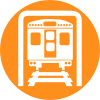 | |
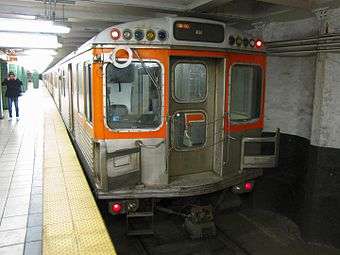 Broad Street Line train at Race–Vine station | |
| Overview | |
| Type | Rapid transit |
| System | SEPTA |
| Status | Operational |
| Locale | Philadelphia, Pennsylvania |
| Termini |
NRG station (south; formerly "AT&T" and "Pattison") 8th & Market (spur south) Fern Rock Transportation Center (north) |
| Stations | 25 |
| Services |
|
| Daily ridership | 123,315 (average weekday FY 2015)[1] |
| Website |
www |
| Operation | |
| Opened | September 1, 1928 |
| Owner | City of Philadelphia |
| Operator(s) |
1928–39: Philadelphia Rapid Transit Co. 1940–68: Philadelphia Transportation Co. 1968–present: SEPTA |
| Character | Underground and surface |
| Technical | |
| Line length | 12.5 mi (20.1 km)[2] |
| Number of tracks | 4 |
| Track gauge | 1,435 mm (4 ft 8 1⁄2 in) standard gauge |
| Electrification | Third rail (600 volts) |
The Broad Street Line (BSL)—also known as the Broad Street Subway (BSS), Orange Line, or Broad Line—is a subway line owned by the city of Philadelphia and operated by the Southeastern Pennsylvania Transportation Authority (SEPTA). The line runs primarily north-south from the Fern Rock Transportation Center in North Philadelphia to Pattison Avenue in South Philadelphia; the latter station provides access to the stadiums and arenas for the city's major professional sports teams, about a quarter mile away. It is named for Broad Street, the street under which it runs for almost its entire length. The line, which is entirely underground except for the northern terminus at Fern Rock, has four tracks in a local/express configuration from Fern Rock to Walnut-Locust and two tracks from Lombard-South to the southern terminus at NRG station. It is one of only two rapid transit lines in the SEPTA system overall alongside the Market–Frankford Line.
The line and its trains were leased to SEPTA in 1968[3] after it assumed operation of the city transit systems from the former Philadelphia Transportation Company (PTC).[4] Broad Street Line subway cars bear both the SEPTA logo and the seal of the City of Philadelphia to reflect the split ownership-operation arrangement.
History
Service on the northern half of the Broad Street Line, between City Hall and Olney Avenue, opened on September 1, 1928. While the original subway tunnel had been finished to just north of the present-day Lombard-South station, service to the Walnut-Locust station did not begin until 1930; the Lombard-South station entered service in 1932. Service from that point south to Snyder Avenue began on September 18, 1938. Service to a new park-and-ride station built next to the Fern Rock shops began in 1956, and the line was extended further south to Pattison Avenue in 1973 to serve the recently completed Sports Complex.[5]
Although the Broad Street Line was originally planned in the 1920s to be a 4-track facility for its entire length (Fern Rock portal to Snyder), the tunnel was built with provision for 4 tracks only from the portal to just north of Lombard-South. At the time of opening, the outer 2 tracks were built along this length, whereas the inner 2 express tracks were built only in two sections, from the Fern Rock portal/shops to just south of Olney, and from Girard to their terminus just north of Lombard South. To close the gaps, the two inner express tracks were laid from Erie to Girard in 1959, and again from Olney to Erie in 1991.
From Lombard-South station south to Snyder, the tunnel was constructed differently – only the eastern half of the line was built. The track currently used for southbound trains is actually the northbound express track. The extension to Pattison Station now called NRG Station in 1973 continued this arrangement. Space exists under the western half of Broad Street for the construction of the western half of the tunnel, which would include the remaining 2 tracks and additional island platforms for southbound local and express trains. The resulting infrastructure would match the configuration built in the northern half of the line.
Provisions for flying junctions exist in the tunnels at three locations: north of Olney station, north of Erie station, and between Tasker-Morris and Snyder stations. These were to connect to planned but never built extensions to the north, northeast, northwest and southwest. Tracks were laid in the upper levels of the flying junctions north of Olney and Erie; these have been used over the years to store out-of-service trains and as layover points for express and Ridge Spur trains.
The NRG Station contains a lower level platform, built to accommodate additional trains for large crowds at sporting events. Seldom used in recent years, these tracks are most often used to store rolling stock and work trains. Two of the Broad Street Subway system's stations have been closed: Spring Garden Station (closed in 1991) on the Ridge Avenue Spur Line and Franklin Square Station on the Former Bridge Line now called PATCO HIGH SPEED LINE (closed in 1953 and later opened in 1976 for Bi-Centennial and then closed again in 1979).
The Broad Street Line is one of only two rapid transit lines in the United States outside of New York City to use separate local and express tracks for a significant length, the other being Chicago's North Side Main Line from Armitage north, used by Purple Line express trains.
Timeline
| Date | Event |
|---|---|
| September 1, 1928 | Original section of subway opens from City Hall to Olney Avenue. Fare is 15 cents (equal to $2.14 today). |
| April 20, 1930 | Extended service from City Hall to South Street. |
| December 21, 1932 | Open Ridge Avenue Spur, service Girard Avenue to 8th and Market Streets |
| September 18, 1938 | Extended south from South Street to Snyder Avenue. |
| August 8, 1943 | Ridge Avenue Spur through-routed with Bridge Line to Camden, New Jersey evenings and Sundays. |
| February 15, 1953 | Discontinued evening and Sunday through service to Camden, all Ridge Avenue Spur trains run to 8th and Market only. |
| September 13, 1953 | Evening and Sunday through service to Camden resumed. |
| September 9, 1956 | Extended north from Olney to Fern Rock (over existing tracks to Fern Rock shops). |
| September 28, 1959 | Weekday and Saturday daytime express service begins following installation of second pair of tracks north to Erie, Ridge Avenue Spur trains extended from Girard to Erie Monday to Saturday daytime. |
| 1965 | Discontinued express service except Monday-Friday rush periods. |
| 1967 | Roosevelt Boulevard Subway station built at Adams Avenue in anticipation of extending the subway along Roosevelt Boulevard. |
| August 27, 1968 | Locust Street-Camden tracks separated from BSL to form PATCO Line. Ridge Avenue south terminal now at a new station at 8th and Market Streets |
| April 8, 1973 | Subway extended from Snyder Avenue to Pattison Avenue sports complex. |
| September 5, 1976 | Discontinue Sunday service on Ridge Avenue Spur. |
| November 19, 1979 | Discontinue express service due to a lack of serviceable cars. |
| February 15, 1981 | Suspend Ridge Avenue Spur service, due to interference with construction. |
| January 3, 1983 | Resume Monday-Friday express service, Olney to Walnut/Locust. |
| September 6, 1983 | Resume Ridge Avenue Spur service. |
| 1991 | Express Tracks extended from Erie to Olney. Broad Ridge Spur Spring Garden Station closes. Olney Terminal is rebuilt. |
| March 12, 1992 | Fern Rock is expanded with a pedestrian walkway to as part of the Railworks Project Regional Rail Lines. |
| October 31, 2008 | Single day ridership record of 404,000 passengers occurs during Phillies World Series Parade event. |
| 2010 | Pattison Station name changed to AT&T Station. |
| 2018 | AT&T Station name changed to NRG Station. |
Proposed extensions
Roosevelt Boulevard
Both the City of Philadelphia and SEPTA have studied extending the Broad Street Line along Roosevelt Boulevard, in order to serve a growing population in the northeast section of the city. The city government's archives contain a survey report, prepared in 1948, discussing a need for an extension of the Broad Street line from Erie Avenue to the vicinity of Pennypack Circle (see Roosevelt Boulevard).[6] Subway car destination signage even included station and terminus names for major streets along Roosevelt Boulevard such as Rhawn Street, in the newer "South Broad" cars. An expansion into another part of the City could better use the capacity of the four-track trunk line.[7]
In 1964, the city proposed a nine-mile (14 km), $94 million extension of the Broad Street line along Roosevelt Blvd. in conjunction with a new Northeast Expressway to be built by the Pennsylvania Department of Transportation. Development was limited to the building of one subway station by Sears, Roebuck and Company in 1967, at its complex on Roosevelt Boulevard at Adams Avenue, at the cost of $1 million, in anticipation of future service. This station was destroyed when the facility was demolished in October 1994.[8][9] Ultimately the Northeast Expressway was never built, due to lack of funds, and the subway extension remained a paper concept.
On September 10, 1999, SEPTA filed a Notice of Intent to prepare an Environmental Impact Statement for the Northeast Extension with the EPA.[10] In December 2001, the Philadelphia City Planning Commission supported extending the Broad Street Line along Roosevelt Blvd. to Bustleton Avenue, where it would be joined by the Market-Frankford Line, extended from its Frankford terminal (now the rebuilt Frankford Transportation Center). The estimated cost had ballooned to $3.4 billion.
Philadelphia Naval Yard
Currently, the Broad Street Line terminates southbound at NRG station at Pattison Ave and three major stadiums. With the redevelopment of the Philadelphia Naval Yard directly to the south, a Health Impact Assessment report was issued in March, 2012 to determine if extending the line to the Naval Yard would be a viable option for commuters. It determined that extending the line to the Naval Yard would more than halve the number of private cars commuting back and forth, with the remainder taking the proposed subway line and/or using a bicycle sidepath. The HIA recommends making an extension of the Broad Street Line a priority, and recently, the extension has garnered much support.[11][12]
West Philadelphia
A report in the 1940s proposed an extension of the Locust St. subway to West Philadelphia. This line would have run under one of the streets presently served by the subway-surface system. Presumably, the current subway-surfaces lines would have been converted to bus operation and would have been used to feed this line. It appears that this proposal was replaced by the extension of the subway portion of the subway-surface system in the 1950s.
Northwest
The same report also proposed a northwest extension. This would have branched off at the North Philadelphia station and would have taken over the Pennsylvania Railroad Chestnut Hill branch which is still operated today as part of SEPTA's Regional Rail system.
Operation
Rolling stock
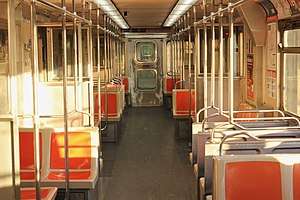
The first set of rail cars for the Broad Street subway was the B-1 cars built in 1926–27 by the J.G. Brill Company. The Pressed Steel Car Company supplied an additional set in 1938 collectively known as the B-2's. The JG Brill Company also built and delivered 26 deluxe art-deco streamlined subway cars to the Delaware River Joint Commission in early 1936 for use on its Bridge Line from 8th and Market into Camden, NJ via the Benjamin Franklin Bridge. These cars were designed to be compatible with the other Broad Street cars, and could run in multiple with them. After the Bridge Line became part of the PATCO Lindenwold Hi-Speedline in late 1968, 23 of these former "Bridge Line" cars were sold to the City of Philadelphia in 1969 to be used on the Broad Street Subway, and were designated as the B-3's, until they were retired by early 1984.
The first set has had the second longest lifespan of any subway car in Philadelphia, after that of the Market Street cars built for what ultimately became the Market–Frankford Line. Although the line was a host for the UMTA's State of the Art Car program, real replacements for the Broad Street cars did not come until late 1982, when SEPTA introduced new "B-IV" cars built by Kawasaki, which are currently the only cars operating the line. A small number of B-1, B-2, and B-3 historic cars remain stored in derelict condition within Fern Rock yard. One car was sent to the Trackside Brick Oven Pizzeria.
Service
Four different services run along the Broad Street Line:
- Local (L) – trains show white marker lights; stops at all stations
- Express (E) – trains show green marker lights; stops at select stations between Fern Rock and Walnut-Locust
- Broad-Ridge Spur (R) – trains show yellow marker lights; features service via Ridge Ave to 8th & Market from Monday-Saturday
- Special (S) – trains show blue marker lights; features service from all express stations to NRG Station for sporting and entertainment events
Panel indicators
|
|
|
|
The Kawasaki B-IV cars feature multi-panel signs to indicate the origin point, destination, and type of service. One sign is mounted on each side of a car, set just inside a window to make it visible from both the interior and exterior. A similar, smaller sign is mounted over car-end doors when cab equipment is present; this sign is only visible from the exterior. These signs were a significant improvement over earlier rolling stock which completely lacked such signage.
Each sign consists of a set of 12 panels arranged in 4 rows of 3 columns each (a 3 x 4 grid). Each panel can be illuminated by an incandescent light bulb. As shown above, the upper three rows indicate station names while the bottom row indicates type of service. Trains normally light three panels: two station names (origin and destination) and a type of service (local, express, or special). Only significant stations are represented in the grid.
In 1982, following delivery of the first significant number of B-IV cars, SEPTA assigned these cars to the restoration of express service. The signs were lit to show "OLNEY" "WALNUT" "EXPRESS". In early 1983, with more B-IV cars arriving and placed into local service, signs showed "FERN ROCK" "PATTISON" "LOCAL". After delivery of the last cars, Broad-Ridge Spur trains showed "ERIE" "8th-MARKET" (rush hour) or "GIRARD" "8th-MARKET" (off-peak and weekends). Special trains showed "FERN ROCK" "PATTISON" "SPECIAL" "EXPRESS". Subsequent changes to express and Broad-Ridge Spur service patterns led to the current signage: express trains show "FERN ROCK" "WALNUT" "EXPRESS" and Broad-Ridge trains show "OLNEY" "8th-MARKET" "EXPRESS" (weekdays) and "FERN ROCK" "8th-MARKET" "EXPRESS" (weekends). In 2010, with the renaming of the terminal, all signs were updated with "AT&T" in place of "PATTISON".
Operating times and headways
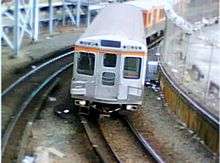
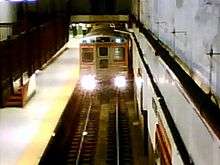
A local trip along the entire line takes about 35 minutes. Trains run from approximately 5:00 am to 1:00 am, with a timed-transfer at 12:30 am at City Hall station to connect with the Market Frankford Line based on final trains. The Broad Street Owl bus service replaces the subway throughout the night Monday through Friday mornings, stopping at the same locations as the subway trains. The line itself ran 24 hours a day until it was eliminated in 1991; it was reinstated on June 20, 2014 for Friday and Saturday overnights only on a trial basis. It was made permanent on October 8, 2014 due to the line successfully carrying an extra 10,000 riders on the Broad Street Line during the weekend overnight periods. Since 2014, the line runs nonstop from 5:00 a.m. on Friday to 1:00 a.m. on Monday morning.
The local portion of the Broad Street Line carries a headway of eight minutes or less during the daytime all day weekdays, 10–12 minutes all day on weekends and major holidays, and 12 minutes in the evenings. Weekend night service consists of a 20-minute frequency, while owl bus service early weekday mornings utilize a 15-minute frequency. The express portion of the line ranges from seven minutes during peak hours to 12 minutes off-peak, while the Broad Ridge Spur ranges from seven minutes during peak hours to 20 minutes off-peak.
| Service | Start Time | End Time |
|---|---|---|
| Northbound train | 5:02 am | 12:55 am |
| Southbound train | 5:00 am | 12:41 am |
| Northbound Night Owl bus | 12:20 am | 5:36 am |
| Southbound Night Owl bus | 12:09 am | 5:35 am |
| Northbound Broad-Ridge Spur (M-F) | 5:45 am | 9:15 pm |
| Southbound Broad-Ridge Spur (M-F) | 5:25 am | 8:48 pm |
| Northbound Broad-Ridge Spur (Sat) | 6:38 am | 9:22 pm |
| Southbound Broad-Ridge Spur (Sat) | 6:15 am | 9:02 pm |
Broad–Ridge Spur

A two-track spur of the Broad Street Line, known as the Broad–Ridge Spur, diverges from the main line at Fairmount. Originally known as the Ridge-8th Street Subway, the line follows Ridge Avenue, from which it takes its name, southeastward from the intersection of Broad Street, Ridge and Fairmount Avenues to a two-level junction beneath 8th and Race Streets, where tunnels leading to and from the Benjamin Franklin Bridge to Camden connect to it, then proceeds south under 8th Street. At its southern terminus at 8th and Market streets, passengers may transfer to the Market-Frankford Line and the PATCO Speedline. Ridge Spur service to 8th and Market streets began in 1932; in 1936, the Delaware River Joint Commission (now Delaware River Port Authority, or DRPA) began operating "Bridge Line" service to 8th and Market from Broadway in Camden, New Jersey, with intermediate stops at Camden City Hall and Franklin Square (now abandoned).
The tunnel continues south under 8th Street from Market to Locust, where it turns west and runs under Locust Street to a terminus at 15th–16th Street station; a two-track tail used for layovers extends from 16th to 18th streets. Though this tunnel was also completed in 1932, it did not open for service until 20 years later; Ridge Spur and Bridge Line trains used it until 1969, when a new DRPA subsidiary, the Port Authority Transit Corporation, began operating the Lindenwold High-Speed Line (PATCO Speedline) through the 8th-Locust subway. At that time, a new single-track, side-platform terminal for Broad–Ridge Spur trains was opened on the upper level of 8th and Market station. The track connection between the Broad–Ridge Spur and the 8th–Locust Street subway was removed and a gate seals the tunnel opening; the tracks now end at a bumper block beyond the end of the platform.
The spur was built as part of a planned downtown subway loop that would have continued west from the current terminus at 18th, turned north under 19th Street, turned east under Arch Street, and re-connected to the Broad Street main line at Arch Street; work began on this loop in 1915 but was canceled the following year due to lack of funding.[13]
Currently the spur operates Mondays through Saturdays from 6 am to 9 pm, running two-car trains on shortened platforms. This is down from five-car trains operated from the line opening through the 1970s, on full-length platforms. In recent years trains operated on a 24-hour schedule, as well as stopping at the Spring Garden Street station during peak hours. Spring Garden Street station was later abandoned for safety reasons and low ridership. Safety concerns also jeopardized the Chinatown station, but community concerns kept it open during peak hours with increased Transit Police Patrols.
Stations
All stations are located in the city of Philadelphia, Pennsylvania. Stations on the Broad-Ridge Spur are shaded in gold. Special extra service for sports and entertainment events make all express stops between Fern Rock to Walnut–Locust and then continue express to NRG.
Services
Local Express Broad–Ridge Spur Special
| Neighborhood | Station | L | E | R | S | Connections | Notes |
|---|---|---|---|---|---|---|---|
| Fern Rock | Fern Rock Transportation Center |
● | ● | ● | ● | ||
| Logan | Olney Transportation Center |
● | ● | ● | ● | Located near La Salle University | |
| Logan | ● | ||||||
| Wyoming | ● | ||||||
| Hunting Park | Hunting Park | ● | |||||
| Erie | ● | ● | ● | ● | Serves Temple University Hospital | ||
| Glenwood | Allegheny |
● | Serves Temple University's dentistry school | ||||
| North Philadelphia |
● | ● | |||||
| Cecil B. Moore | Susquehanna–Dauphin | ● | Originally named Dauphin-Susquehanna | ||||
| Cecil B. Moore |
● | Serves Temple University, originally Columbia Avenue | |||||
| Francisville | Girard |
● | ● | ● | ● | ||
| Fairmount | ● | ● | |||||
| Callowhill | Spring Garden | Closed since 1991 | |||||
| Chinatown | Chinatown | ● | Originally named Vine | ||||
| Market East | 8th & Market |
● | Originally named Market Street | ||||
| Chinatown | Spring Garden |
● | ● | ● | Serves the Community College of Philadelphia | ||
| Race–Vine | ● | ● | ● | Serves the Pennsylvania Convention Center and Hahnemann University Hospital | |||
| Center City | City Hall | ● | ● | ● | Located in the Center City Commuter Connection concourse | ||
| Washington Square West | Walnut–Locust |
● | ● | ● | Serves the Kimmel Center and Academy of Music | ||
| Lombard–South | ● | Serves University of the Arts, Peirce College, and Graduate Hospital | |||||
| South Philadelphia | Ellsworth–Federal | ● | Serves the Italian Market | ||||
| Tasker–Morris | ● | ||||||
| Snyder | ● | Serves Methodist Hospital | |||||
| Oregon |
● | Serves Marconi Plaza | |||||
| NRG |
● | ● | Serves the South Philadelphia Sports Complex, originally named Pattison |
References
- ↑ SEPTA. "SEPTA Route Statistics" (PDF).
- ↑ "Philadelphia, Pennsylvania: The Broad Street Subway".
- ↑ "Student Voices: Phila. threatens to seize subways from SEPTA".
- ↑ SEPTA. "SEPTA history". Archived from the original on May 20, 2007.
- ↑ "Stations of The Broad Street Subway". 1 Mar 2009. Archived from the original on 30 April 2001. Retrieved 11 March 2016.
- ↑ City archive on BSS
- ↑ Pennsylvania Transit Expansion Coalition (PA-TEC). "Broad Street Line – Boulevard Extension".
- ↑ Phillyroads.com. "Broad Street Subway".
- ↑ "Secrets Beneath the Streets".
- ↑ "Environmental Impact Statement on Transportation Improvements Within the Roosevelt Boulevard Corridor in Philadelphia, Pennsylvania". Federal Register. 64 (175): 49271–49273. September 10, 1999. Retrieved 10 May 2015.
- ↑ Smith, Sandy (November 16, 2015). "Navy Yard Subway Extension Update: Funding for New Feasibility Study Secured". Phillmag.com. Metro Corp.
- ↑ "LOWER SOUTH DISTRICT HEALTH IMPACT ASSESSMENT: Summary Report" (PDF). Philadelphia City Planning Commission. March 2012.
- ↑ World.nycsubway.org: Philadelphia: SEPTA Broad Street Subway
External links
Route map:
| Wikimedia Commons has media related to Broad Street Line. |